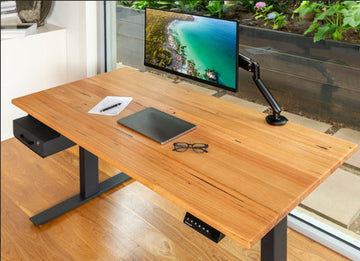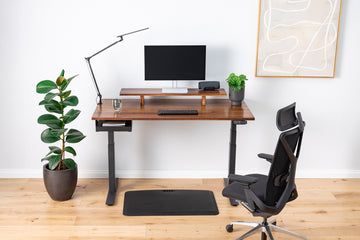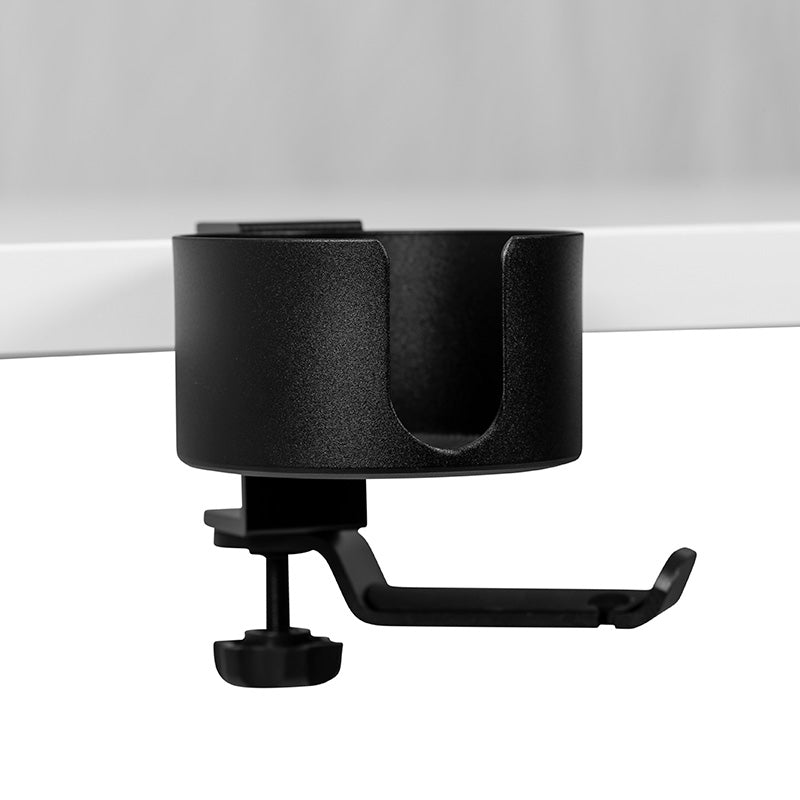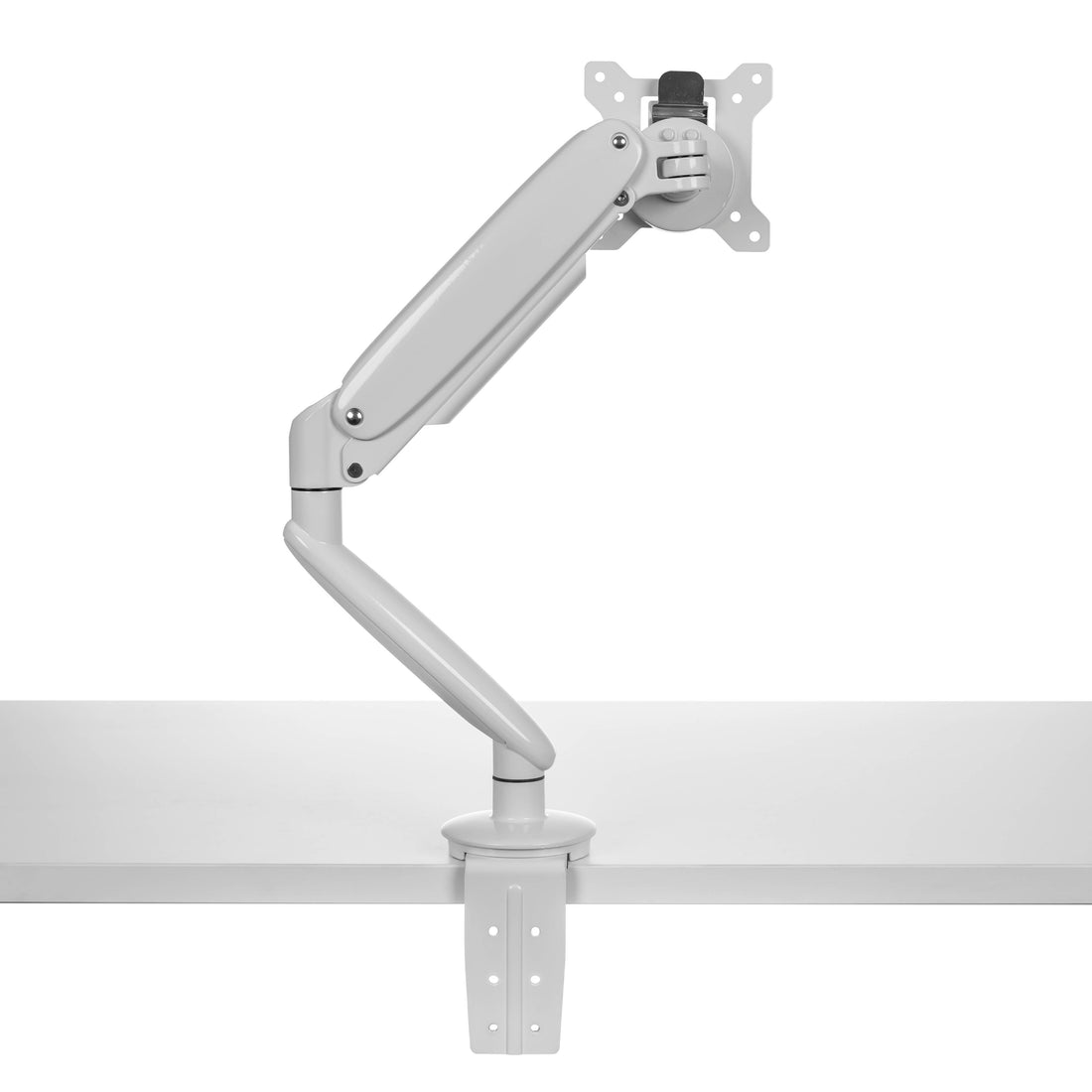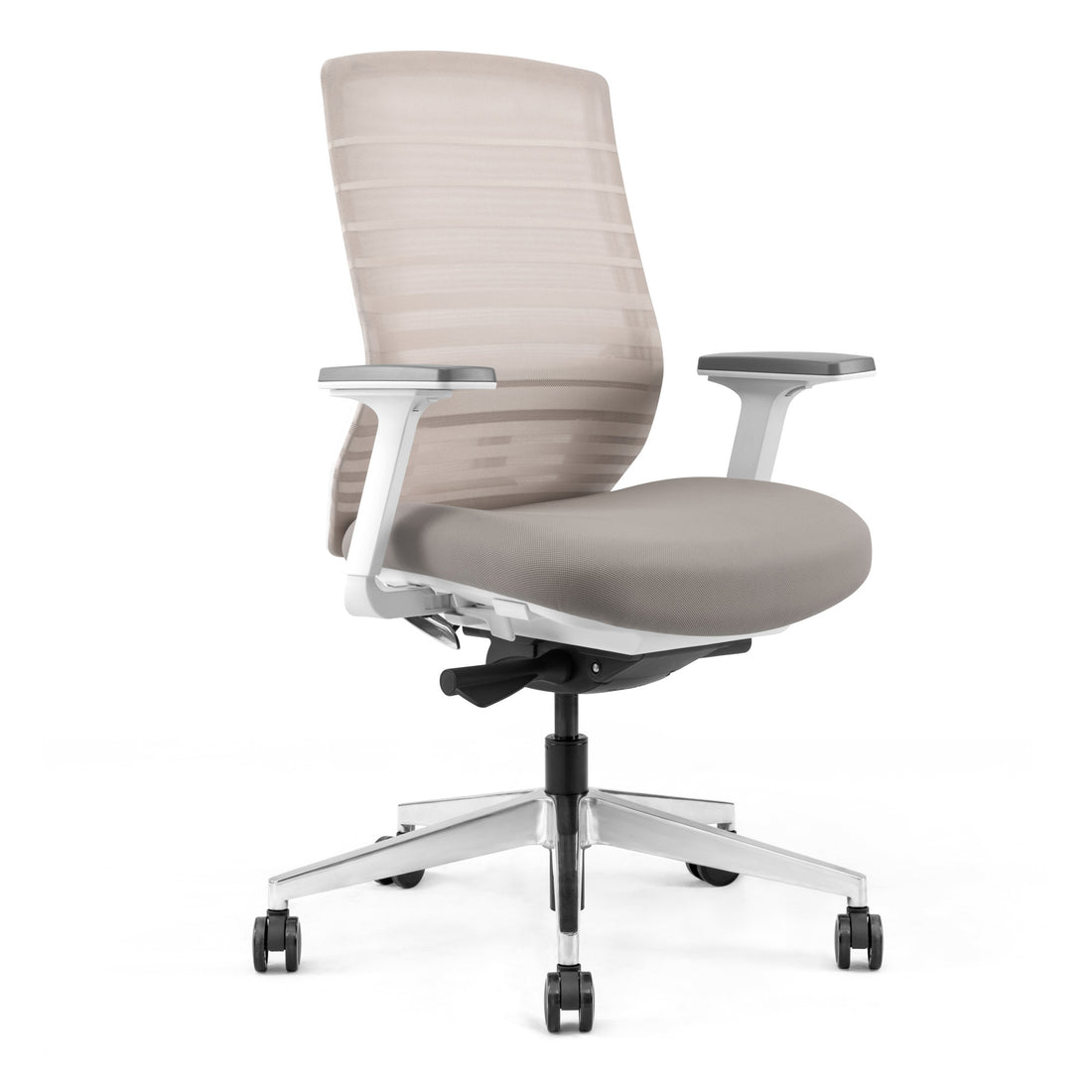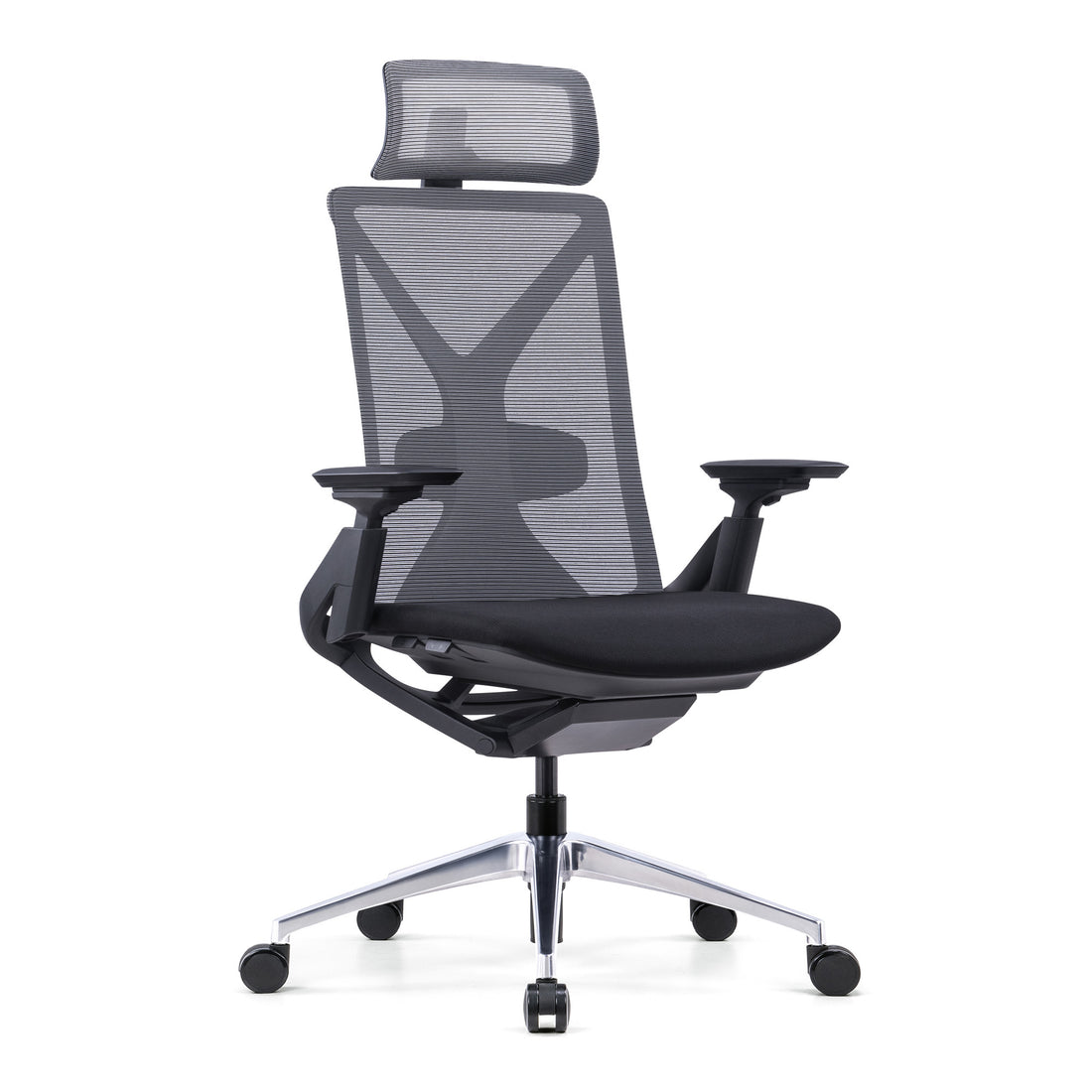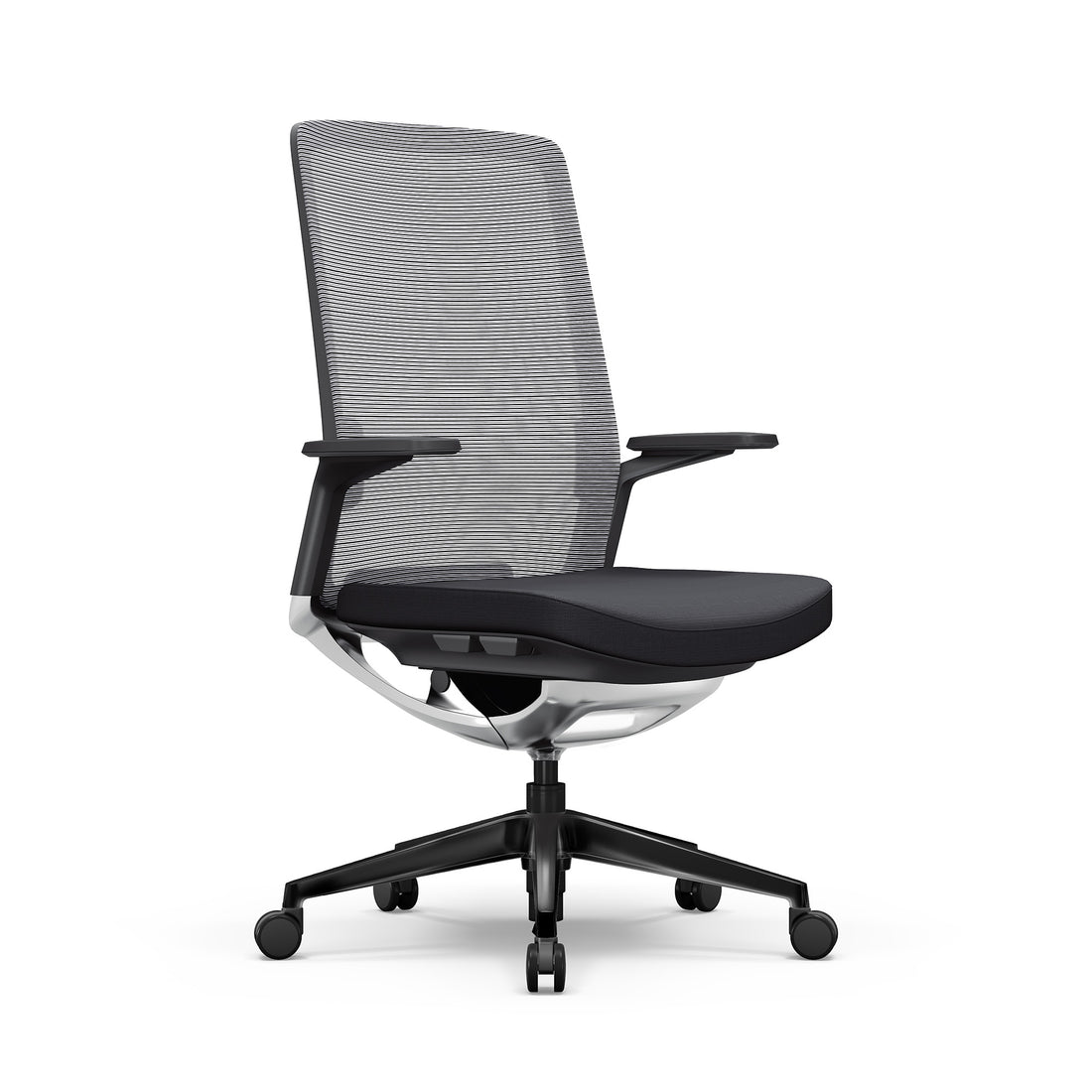Selecting the right material for your desktop is a crucial decision that can significantly impact your workspace's aesthetics, durability, and functionality. Whether you're setting up a home office, a corporate environment, or a creative studio or choosing materials for a standing desk, the desk's material plays a pivotal role in defining the overall look and feel of the room.
From the rich texture of hardwood to the sleek finish of engineered alternatives, each material brings its own set of advantages and considerations. In this guide, we'll explore the best wood for desktops, delve into various materials, and provide insights into making an informed decision that suits your needs and style preferences.
What Are Desks Made Of?
Desks are crafted from various materials, each chosen for its unique properties and suitability for different environments. The materials range from traditional woods to modern composites and metals, each offering a distinct aesthetic and functional advantage.
Desk Material Selection for Different Uses
When considering what desks are made of, it's important to evaluate the various materials available, each offering distinct characteristics suited to different environments and purposes. Conducting a timber comparison can be particularly helpful in understanding the differences between natural wood options. Here are some of the most common materials used in desk construction:
- Wood: Wood is a timeless choice for desks, offering a combination of durability, warmth, and natural beauty. Hardwoods like oak and maple are popular for their strength and resilience, making them ideal for both home and office settings. Softwoods and engineered woods provide a more affordable alternative while still offering an attractive appearance.
- Metal: Known for its industrial appeal, metal desks are durable and easy to clean. They are perfect for modern and minimalist designs, offering a sleek, sturdy surface that withstands heavy use. Metal desks can be paired with glass tops or wooden accents to soften their look and add warmth.
- Glass: Glass desks provide a contemporary and elegant appearance and are often used in modern office spaces. While visually appealing, glass requires more maintenance to keep it clean and free from fingerprints. It pairs well with metal frames, creating a stylish and sophisticated look.
- Melamine: This engineered material is known for its affordability and versatility. Melamine desks are available in a wide range of finishes and colors, making them an excellent choice for those seeking a budget-friendly option that doesn't compromise style. They also resist scratches and stains, making them practical for everyday use.
- Bamboo: An eco-friendly option, bamboo is gaining popularity due to its sustainability. It grows quickly, making it a renewable resource. Bamboo desks offer a modern look with their light color and smooth texture. They are sturdy yet lightweight, making them easy to move and rearrange.
Whether you need a durable surface for heavy work or a stylish addition to your home, understanding the characteristics and benefits of these materials will help you choose the best desk for your specific needs.
Comparison Table of Types of Wood for Desktops
To assist in selecting the best wood for your desktop, we've compiled a comprehensive comparison table highlighting various factors such as durability, appearance, cost, and more. This table serves as a quick reference guide to help you weigh the pros and cons of each wood type.
| Wood Type | Durability | Appearance | Workability | Maintenance | Sustainability | Pros | Cons |
| Oak | High | Traditional | Easy | Moderate | High | Durable, rich texture | Expensive |
| Maple | Very High | Light, smooth | Moderate | Low | Moderate | Strong, light-color | Can be heavy |
| Walnut | Medium | Dark, elegant | Moderate | High | Moderate | Luxurious, unique grain | Expensive |
| Cherry | High | Reddish-brown | Easy | Moderate | High | Warm tones, ages well | Prone to scratches |
| Rubberwood | Medium | Light, eco-friendly | Easy | Low | High | Affordable, sustainable | Moderate durability |
| Bamboo | High | Modern, sleek | Easy | Low | Very High | Eco-friendly, durable | Limited color range |
| Melamine | Medium | Versatile | Easy | Low | High | Affordable, easy to maintain | Not as durable as solid wood |
| Acacia | High | Vibrant, unique grain | Moderate | Low | High | Durable, water-resistant | Heavy |
| Messmate | Medium | Attractive grain, mixed shades | Moderate | Moderate | High | Versatile, affordable | Requires regular sealing |
Types of Wood for Desktops
Choosing the right type of wood for your desktop is a key decision that involves considering factors such as durability, appearance, and cost. This section will delve into the most popular wood choices and explore why they are highly recommended for desktop use.
Best Wood for Desktops
When it comes to selecting the best wood for desktops, several options stand out due to their unique properties and benefits. Let's explore some of the top choices:
- Oak: Oak is renowned for its strength and durability, making it one of the best options for desktops. Its robust nature allows it to withstand heavy use, making it ideal for both home and office environments. Oak's rich texture and traditional appearance add a touch of elegance to any room. It is available in various shades, from light to dark, allowing for versatility in design. However, oak can be relatively expensive, and its heavy weight may pose challenges during installation and relocation.
- Maple: Maple is another excellent choice, known for its fine grain and light color. It provides a smooth and even surface, perfect for precise activities such as writing or drawing. Maple is highly durable and resistant to wear and tear, making it suitable for high-traffic areas. Its lighter shade complements modern and minimalist interiors, offering a clean and fresh look. Despite its durability, maple can be heavy, making it less ideal for those who frequently move their desks.
- Walnut: Walnut is prized for its rich, dark color and unique grain patterns. This wood exudes a sense of luxury and sophistication, making it a favorite for high-end furniture and executive desks. Walnut is relatively hard, offering good resistance to dents and scratches. Its elegant appearance makes it a focal point in any room, enhancing the overall decor. However, walnut is one of the more expensive wood options, and its maintenance can be more demanding, requiring regular polishing to maintain its luster.
- Cherry: Cherry wood is known for its warm, reddish-brown hue and smooth texture. It has a fine, straight grain that gives it a sleek and elegant appearance. One of the unique features of cherry wood is its ability to darken over time, developing a rich patina that adds depth and character. Cherry is moderately hard, making it durable enough for regular use. It is often used in luxury furniture and high-end desks. However, cherry wood can be prone to scratches, requiring careful handling and regular maintenance.
- Acacia: Acacia wood is celebrated for its rich color variations and striking grain patterns, creating a unique and vibrant aesthetic. Renowned for its exceptional durability and resistance to scratches, acacia is an ideal choice for the demands of everyday use, particularly in acacia desks. Its natural oils provide added protection against water and mold, ensuring longevity and low maintenance. The distinctive look of acacia brings a rustic charm to any space, although its weight may require sturdy support for larger pieces of furniture.
- Messmate: Messmate is known for its versatility and attractive grain. It features a mix of light and dark shades that create a visually appealing desktop. This wood is moderately hard, offering good durability for everyday use. Messmate's unique texture adds a natural, earthy feel to interiors, making it suitable for both traditional and contemporary designs. While it provides an affordable alternative to more expensive wood, it may require regular sealing to maintain its appearance and protect it from wear.

Bamboo vs Solid Wood Desk
Bamboo has become a popular alternative to traditional solid wood as environmental consciousness grows. Bamboo desks offer several advantages, particularly in terms of sustainability and cost-effectiveness. However, there are also considerations to consider when comparing bamboo to solid wood options.
Pros of Bamboo:
- Eco-friendly: Bamboo is one of the fastest-growing plants, making it a highly renewable resource. Its cultivation requires fewer pesticides and fertilizers, making it an environmentally friendly option.
- Lightweight: Bamboo is lighter than most hardwoods, making it easier to move and rearrange. This feature is particularly useful for those who frequently change their workspace layout.
- Affordable: Bamboo is generally more affordable than solid wood, making it accessible to more consumers.
Cons of Bamboo:
- Limited color options: Unlike solid wood, which offers a variety of natural hues, bamboo typically comes in lighter shades. While it can be stained, the options are more limited.
- Durability: While bamboo is durable, it may not match the longevity of solid hardwoods like oak or maple. If not properly maintained, it can be prone to scratches and dents.

In comparison, solid wood desks offer a different set of pros and cons:
Pros of Solid Wood:
- Aesthetic Variety: Solid wood provides a wide range of natural colors and grain patterns, from walnut's rich tones to maple's light hues. This variety allows for greater customization and style.
- Durability: Solid wood is generally more durable and can withstand the test of time. Hardwoods like oak and maple are known for their strength and resistance to wear, making them ideal for long-term use.
Cons of Solid Wood:
- Heavier: Solid wood desks are typically heavier than bamboo, making moving less convenient. This can be a drawback for those who frequently rearrange their workspace.
- Cost: Solid wood tends to be more expensive than bamboo, which can be a limiting factor for budget-conscious consumers.
Both bamboo and solid wood desks offer unique advantages and drawbacks, making them suitable for different preferences and needs. Ultimately, the choice between a bamboo vs solid wood desk depends on your priorities, such as sustainability, durability, aesthetics, and budget.
Solid Wood vs Hardwood Desk
The choice between solid wood and hardwood desks often depends on personal preference and budget. Solid wood desks are crafted from a single type of wood, offering a cohesive and natural look. They showcase unique grain patterns and colors, making each piece distinct.
Solid Wood:
- Natural beauty: Solid wood desks highlight the natural variations in color and grain, making them visually appealing.
- Longevity: Solid wood desks can last for generations with proper care, making them a worthwhile investment.
- Customizable: Solid wood can be easily refinished, allowing for customization and restoration.
Hardwood:
- Durability: Hardwoods like oak, maple, and walnut are known for their strength and resistance to wear and tear. They are less likely to dent or scratch, making them ideal for heavy-use areas. Additionally, some wood desktops include recycled options, presenting a sustainable and eco-conscious choice with visually appealing results. Recycled messmate desks are one of the most popular options, combining durability with sustainable practices by repurposing wood from other sources.
- Consistency: Hardwood desks often have a more uniform appearance, which can be desirable for those seeking a consistent look.
Alternative Materials
While wood remains a popular choice for desktops, alternative materials like melamine offer practical benefits. Melamine is an engineered wood product with a particleboard or MDF core covered with a melamine resin. This coating makes it resistant to scratches, stains, and heat, providing a durable and easy-to-clean surface.
Melamine
Melamine is an engineered wood product with a particleboard or MDF core covered with a melamine resin. This coating makes it resistant to scratches, stains, and heat, providing a durable and easy-to-clean surface.
Pros of Melamine
- Cost-effective: Melamine desks are generally more affordable than solid wood desks, making them a popular choice for budget-conscious consumers.
- Versatile: Available in a wide range of colors and finishes, melamine can mimic the look of natural wood, providing aesthetic flexibility.
- Low maintenance: The melamine surface is easy to clean and does not require special care, making it a convenient option for busy individuals.
Cons of Melamine
- Durability: While melamine is resistant to surface damage, it is not as durable as solid wood. The core material can be vulnerable to moisture and may swell if exposed to water.
- Aesthetic limitations: While melamine can imitate the appearance of wood, it does not offer the same tactile feel and natural beauty as real wood.
Laminate
Laminate desktops combine plastic and wood products, offering a budget-friendly and versatile alternative to solid wood.
Pros of Laminate
- Affordability: Laminate is typically more affordable than solid wood or other premium materials.
- Variety: Laminate comes in various colors, patterns, and textures, allowing for diverse design possibilities.
- Durability: Laminates resist scratches, stains, and moisture, making them a practical choice for high-traffic areas.
Cons of Laminate
- Less natural feel: While laminate can mimic the appearance of wood, it lacks the natural warmth and texture of real wood.
- Susceptibility to damage: Laminate can chip or peel over time, especially around edges and corners.
Best Wood For A Standing Desk
Standing desks are becoming increasingly popular as more people recognize the health benefits of reducing sedentary behavior. When selecting the best wood for a standing desk, it's important to consider its stability, weight, and overall durability. Additionally, the wood must support the weight of the equipment and withstand the constant adjustments associated with changes in standing desk height. The compatibility of the wood with standing desk frames is also crucial, as a sturdy frame can enhance the desk's overall stability and functionality.
Below are some of the best wood options for standing desks, each offering unique benefits:
- Oak: Oak is an excellent choice for standing desks due to its robustness and stability. Its heavy weight ensures that the desk remains steady during use, even when adjusted frequently. Oak's traditional appeal also adds a touch of elegance to the workspace.
- Maple: Maple's durability and smooth surface make it suitable for standing desks. Its light color and fine grain provide a clean and modern look, ideal for contemporary office environments. Maple is also resistant to wear and tear, making it a practical choice for frequently used desks.
- Walnut: For those looking for a luxurious and sophisticated option, walnut is a top contender. Its rich, dark color and unique grain patterns make it a statement piece in any office. Walnut is moderately hard, offering good durability while maintaining a refined appearance.
These woods provide the necessary stability for standing desks and enhance the workspace's overall aesthetic. Whether you prefer oak's classic look, maple's modern appeal, or walnut's luxurious finish, each wood type offers distinct advantages.
How Desk Materials Affect Ergonomics
The material of your desk plays a significant role in determining its ergonomic qualities. A well-designed ergonomic desk can help reduce strain and discomfort, promoting better posture and overall well-being. Several factors should be considered when choosing the material for an ergonomic desk:
- Surface Smoothness: The smoothness of the desk surface can impact the ease of movement for items like keyboards and mice. Materials like maple and melamine provide a smooth and even surface, allowing for effortless movement and reducing strain on the wrists. This is particularly important for individuals who spend long hours typing or using a mouse.
- Desk Stability: The desk's stability is crucial for maintaining a comfortable and consistent workspace. Heavier woods like oak provide a solid foundation, preventing the desk from wobbling or shifting during use. This stability is especially important for standing desks, where frequent adjustments can compromise the desk's steadiness.
- Material Weight: The weight of the desk material can also affect ergonomics. While heavier woods offer better stability, they can be challenging to move or adjust. Lighter materials like bamboo or metal are easier to reposition, benefiting those frequently changing their workspace layout.
Overall, the choice of desk material should align with the user's ergonomic needs and preferences. A well-chosen desk can significantly enhance comfort and productivity, making it an essential component of an ergonomic workspace.
Choosing the Right Wood for Your Desktop
When it comes to selecting the right wood for your desktop, there are several factors to consider, especially if you're looking for the best table top material. The choice will depend on your budget, style preference, and the specific needs of your workspace. Here are some key considerations to keep in mind:
- Budget: The cost of wood can vary significantly depending on the type and quality. Hardwoods like walnut and cherry tend to be more expensive, while more affordable options include rubberwood and bamboo. Determine your budget beforehand and consider the long-term value of investing in a high-quality material.
- Durability: Consider how much wear and tear the desk will endure. Opt for durable woods like oak or maple if you need a desk that can withstand heavy use. Rubberwood and melamine are cost-effective options for lighter use that offer sufficient durability.
- Aesthetics: The desk's appearance is an important factor, especially if it will be a focal point in the room. Each wood type has its unique grain pattern and color. For a classic and traditional look, consider oak or cherry. For a modern and minimalist style, maple and bamboo are excellent choices.
- Maintenance: Different woods require varying levels of maintenance. Walnut and cherry may need regular polishing to maintain their rich color, while melamine and bamboo are low-maintenance options. Consider how much time and effort you will spend caring for your desk.
Tips for Choosing:
- Match the wood type with the overall decor of the room.
- Consider the functional needs of the desk, such as storage and space requirements.
- Think about the long-term durability and how the wood will age over time.
By carefully considering these factors, you can select a wood type that meets your practical needs and enhances the aesthetic appeal of your workspace.
How to Care for Different Wood Desks
Proper care and maintenance are essential to keep your wood desk looking its best and ensure its longevity. Each type of wood has specific care requirements, which can help prevent damage and maintain the desk's beauty. Here are some general tips for caring for different wood desks:
- Regular Dusting: Dust can accumulate on the desk's surface and cause scratches over time. Use a soft, dry cloth or a microfiber duster to remove dust regularly. Avoid using rough or abrasive materials that can scratch the surface.
- Polishing: Depending on the type of wood, polishing can enhance the desk's finish and protect it from wear. Use a wood-specific polish or wax to maintain the luster of hardwoods like walnut and cherry. Be sure to follow the manufacturer's instructions and avoid over-applying polish, which can lead to buildup.
- Cleaning: Use a damp cloth with mild soap and water for daily cleaning. Avoid harsh chemicals that can damage the wood's finish. For tougher stains, use a specialized wood cleaner. Always dry the surface thoroughly after cleaning to prevent water damage.
- Preventing Damage: Protect your desk from direct sunlight, which can cause fading and discoloration. Use coasters and placemats to prevent water rings and scratches. If you need to move the desk, lift it instead of dragging it to avoid damaging the legs and joints.
- Repairs: Minor scratches and dents can often be repaired with wood filler or touch-up markers. For more significant damage, consider consulting a professional furniture repair specialist.
By following these care guidelines, you can preserve the appearance and integrity of your wood desk for years to come. Regular maintenance enhances the desk's aesthetic appeal and ensures its functionality and durability.
Conclusion
In conclusion, choosing the best wood for your desktop requires careful consideration of various factors, including durability, appearance, cost, and maintenance. Whether you opt for the classic appeal of oak, maple's modern elegance, or walnut's luxurious finish, each wood type offers unique benefits that can enhance your workspace. Additionally, alternative materials like melamine and bamboo provide practical and eco-friendly options that cater to various preferences and budgets.
Ultimately, the right choice depends on your needs and aesthetic preferences. By understanding the characteristics of different wood types and considering factors such as ergonomics and care requirements, you can select a desktop material that meets your functional needs and complements your style. A well-chosen desk can significantly enhance your productivity and comfort, making it a valuable investment for your workspace.
FAQ
What Wood Are Desks Made Of?
Desks are primarily crafted from wood, though materials like metal, glass, and engineered wood are also common. The type of wood used significantly influences a desk's appearance, durability, and price.
What Is a Best Wood for Computer Desk?
Hardwoods like oak, walnut, and maple are popular choices for computer desks due to their durability and aesthetic appeal. These woods can withstand daily wear and tear while maintaining their appearance.
Which Wood Is Best for Office Desk?
Oak, walnut, and maple are commonly used for office desks. They offer a professional and sophisticated look. Their durability and ability to accommodate various finishes make them versatile options for different office styles.
What Material Should I Use for a Desktop?
The best material for a desktop depends on your needs and preferences. Wood, especially hardwoods like oak and walnut, offers durability and natural beauty. However, engineered wood, metal, and glass are also viable options with their advantages.
How Does Bamboo Compare to Solid Wood?
Bamboo is a sustainable alternative to solid wood. It’s often as strong or stronger, lighter, and more affordable. However, solid wood generally offers a wider range of aesthetics and finishes.
What Are the Most Durable Desk Materials?
Hardwoods like oak and maple are renowned for their durability. Engineered wood and metal are also strong options. Your desk's specific durability needs will influence the best choice.
What Factors Should I Consider When Choosing Desk Materials?
When selecting desk materials, consider your budget, desired style, required durability, necessary maintenance, and environmental impact.
What Are the Pros and Cons of Melamine vs. Solid Wood for Desktops?
Melamine desktops are budget-friendly, easy to clean, and available in various colors. However, they lack the natural beauty and durability of solid wood. Solid wood desktops offer a timeless look, durability, and the ability to be refinished, but they are generally more expensive and require more maintenance.

